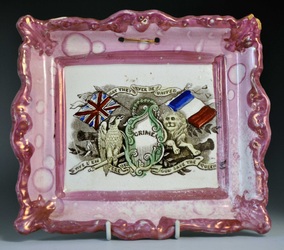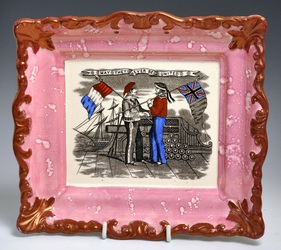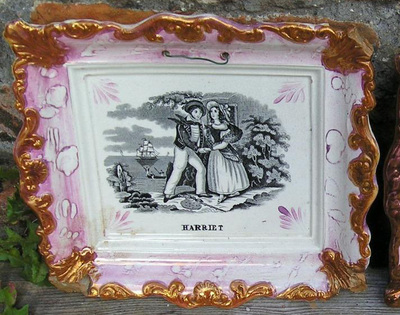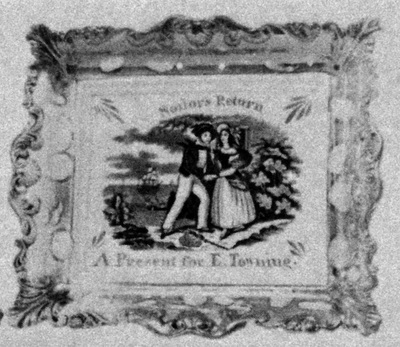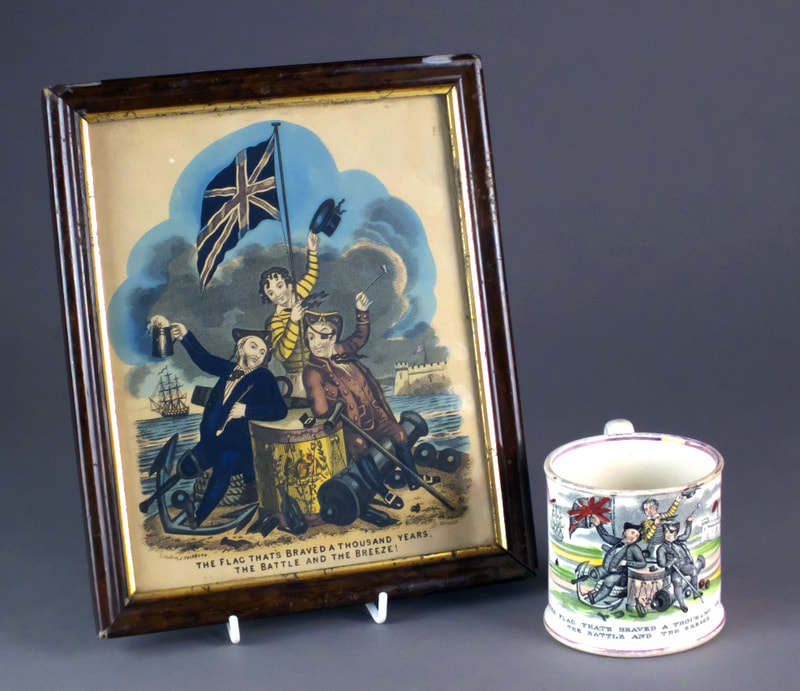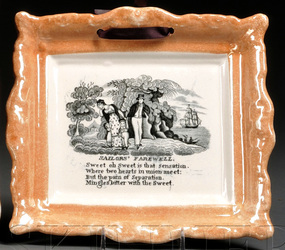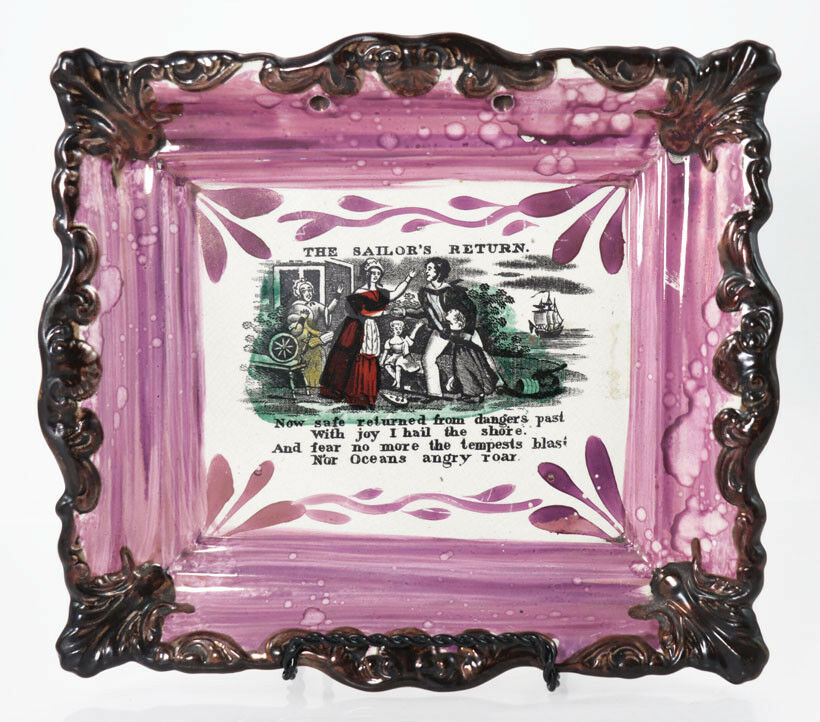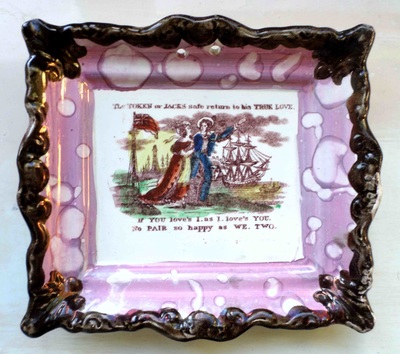For an overview of maritime plaques, click on the Maritime heading above. Click on images to enlarge.
Other maritime subjects
Crimean War
The Crimean War drove a boom in pottery production. Plaques on the wall and figures on the mantlepiece, helped the still largely illiterate populous to make sense of events many miles away. Crimean War-related plaques were made post 1855. The transfers were used over a long period, the ships appearing on orange wares perhaps until the turn of the 20th century.
|
Staffordshire figures of Vice-Admiral Sir Charles Napier (left) and Rear-Admiral Richard Dundas (right) with a plaque depicting their flagship, 'DUKE OF WELLINGTON - 131 GUNS'.
|
Figure of French soldier and English sailor with flags (left). A two-sided figure with an English sailor on one side, and a French soldier on the other (right).
|
May they ever be united
The first three plaques all have the impressed mark 'Dixon Co'. Top left, French and English sailors carrying flags. Top centre, a plaque with Emperor Napoleon and Queen Victoria, surmounted by a lion and a unicorn. Top right, a variation of the first transfer but with two soldiers. Bottom row, two plaques with an eagle and a lion, and French and British flags, around the title 'CRIMEA'. The text on the plaques reads: 'MAY THEY EVER BE UNITED.', 'CRIMEA', 'VIVE L'EMPEREUR' and 'GOD SAVE THE QUEEN.' The top row have the impressed mark 'Dixon Co'. The plaques on the bottom row are unmarked, but are attributed to Moore's.
The three plaques above, although unmarked, are attributed to Adams Pottery, Staffordshire. They are copies/imitations of Sunderland plaques, and were likely made c 1900–1930. The blue-bordered version is exceptionally rare.
Always Ready
Four rare plaques attributed to Moore & Co. The first three from c1855, the third from c1860s.
Red, White, and Blue
Attributed to Moore's, c1855.
Incidents of the War
These rare plaques showing incidents from the Crimean War are attributed to C T Maling. Captions from top down: 'Arrival of post in the army before Sebastopol'; 'Foraging party in the Crimea'; 'A convalescent from Inkermann'; Wounded sailors from the Crimea. There are two more transfers in this series, which I've yet to record: 'Fight in Trenches' and 'Naval Brigade'.
Seaham Sailor's Return and 'Paul Jones'
The two plaques above, attributed to Seaham, have hand-painted inscriptions. The first is to 'Harriet', presumably a sailor's sweetheart. The second has the title 'Sailor's Return', and the inscription, 'A Present for E Towning'. It pairs with another titled 'Paul Jones', below. Read more about the Seaham Pottery 'Sailor's Return' here.
This untitled transfer, also attributed to Seaham, has been said to depict Byron, perhaps on one of his Greek adventures. Byron had a personal connection to Seaham, having been married at Seaham Hall in 1815. However, the image has been recorded with the hand-painted title Paul Jones. Read more about the Seaham Pottery 'Paul Jones' transfer here.
The Flag that Braved a Thousand Years
The plaque above of a form attributed to Scott's Pottery. Although this transfer rarely appears on plaques, variations from both Sunderland and Tyneside are commonly found on mugs, jugs and bowls.
THE FLAG THAT BRAVED A THOUSAND YEARS
THE BATTLE AND THE BREEZE
THE FLAG THAT BRAVED A THOUSAND YEARS
THE BATTLE AND THE BREEZE
The Sailor's Farewell
The top three plaques are attributed to Moore & Co's Wear Pottery (read more here). The bottom left and centre have 'Dixon Co' impressed marks, and were made at the Garrison Pottery (see here). The orange plaque is later, and perhaps attributable to Ball's Deptford Pottery.
|
SAILORS' FAREWELL
Sweet, oh sweet is that sensation, Where two hearts in union meet; But the pain of separation, Mingles bitter with the sweet. |
THE SAILOR'S FAREWELL
Far from Home across the Sea To Foreign climes I go. While far away O think of me And I'll remember you. |
The unmarked jug above has flower decoration typical of Scott of Southwick. It shows another version of the sailor's farewell and return. The 'return' appears on rectangular plaques with straight edges (see last image in the section below). The 'farewell' is yet to be recorded on a plaque.
Another variation of the transfer on a plaque form typical of Scott's, c1870.
The Sailor's Return
The first 4 plaques are attributed to Moore & Co's Wear Pottery, and the last to Scott's Southwick Pottery (read more here).
THE SAILOR'S RETURN
Now safe returned from dangers past
With joy I hail the shore.
And fear no more the tempests blast
Nor Oceans angry roar.
Now safe returned from dangers past
With joy I hail the shore.
And fear no more the tempests blast
Nor Oceans angry roar.
The Token or Jack's Safe Return to his True Love
The first plaque form above is attributed to Moore's Wear Pottery, and the second to Scott of Southwick (read more here).
|
The text on the plaque reads:
The TOKEN or JACKS safe return to his TRUE LOVE. If YOU love's I. as I. love's YOU. No PAIR so happy as WE. TWO. |
The image is reminiscent of theatrical prints. The caption on this one reads:
MR. T.P. COOKE as BEN BACKSTAY. London. Published April 9th 1832. by Orlando Hodgson. 10. Cloth Fair. |
However, whereas the sailor in the print is holding a bag of money, marked 'prize', Jack is holding something else – 'the token'. A caption in the Sunderland Museum informs us it is 'a hot-cross bun, baked by his sweetheart. The buns were given to sailors at the beginning of a voyage, and kept in sea chests to protect against death.'
Smaller sized plaques
These Moore transfers also appear on smaller Moore plaques (below left and right). The centre image shows the difference in size to the more common large brown-bordered plaque. Read more here.






